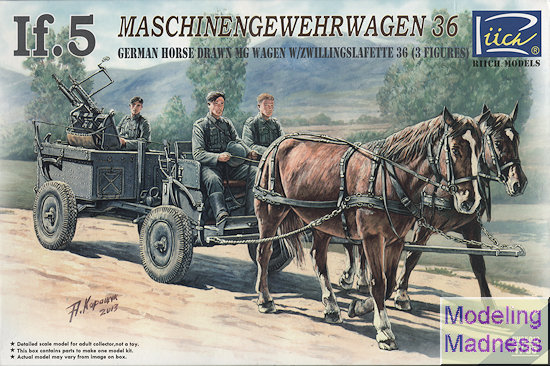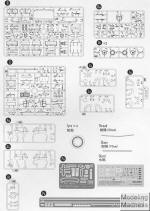
| KIT #: | RV 35012 |
| PRICE: | $67.00 SRP |
| DECALS: | Three options |
| REVIEWER: | Scott Van Aken |
| NOTES: | Includes photo etch |

| HISTORY |
The German Army of the late 1930's was still heavily reliant on horse drawn transport, ranging from wooden or metal cargo wagons, to machine gun carriers. The machine gun wagon was first used in WWI mostly by German and Russian armies, and in the German army it continued into WWII. The Maschinengewehrwagen 36, also known as the If.5, was the most widely used. It was a four wheel wagon carrying a Zwillingsockel 36, mounting twin 7.92 mm MG.34 machine guns in a rear 'box' compartment. The spares and ammunition were stored in the forward section. The driver and his assistant were seated on top of the forward stowage box. In normal use the IF.5 was pulled by two horses, but four could be used in bad conditions. The If.5s were mostly used by second line infantry divisions on the Russian front.
| THE KIT |
 I can't say that I've ever heard of this vehicle, but we now have a kit of it. There are really three main sections of the kit when it comes to construction. The rear section contains the twin machine guns and uses much of the smaller etched fret. There are armored plates on the upper portion of the rear box that can be posed raised to provide the gunner a bit of additional protection. Another option is a pair of what seems to be foot steps or access doors on the front of the cat that can be raised or lowered.
I can't say that I've ever heard of this vehicle, but we now have a kit of it. There are really three main sections of the kit when it comes to construction. The rear section contains the twin machine guns and uses much of the smaller etched fret. There are armored plates on the upper portion of the rear box that can be posed raised to provide the gunner a bit of additional protection. Another option is a pair of what seems to be foot steps or access doors on the front of the cat that can be raised or lowered.
Inside is a mount for the gun that includes a seat for the gunner as well as the twin machine guns. These guns can be posed either in ther travelling or firing position. Both the front and rear carts have vinyl tires that can be fitted to the chassis.
The front of the cart carries most of the pioneer tools as well as providing storage for the crew's guns and other equipment. The forward portion contains the drawbar and harness attachment points. Two horses are provided and the longer of the two frets contains parts for their harness, including a forward chain and the long reins. A full harness rigging diagram is provided. You even get p.e. horseshoes. A saddle is provided for one of the two horses should the builder wish to install it. It was not uncommon to keep one of the horses saddled. Also included in the kit are three figures. These are for the driver, his assistant and the gunner.
two frets contains parts for their harness, including a forward chain and the long reins. A full harness rigging diagram is provided. You even get p.e. horseshoes. A saddle is provided for one of the two horses should the builder wish to install it. It was not uncommon to keep one of the horses saddled. Also included in the kit are three figures. These are for the driver, his assistant and the gunner.
Instructions are quite well drawn and provide color information where it is needed. The instructions themselves also have quite a bit of color in them. There are markings options for three vehicles, two in Panzer Grey and one in a tan, green, brown scheme. Two options are from before the war and one is from the 1941 time period. The decal sheet is nicely printed.
| CONCLUSIONS |
Nice to see some of this early horse-drawn equipment being released in kit form. Not many modelers are comfortable doing kits with horses, but they sure do make for an interesting subject. This one is typical of Riich in that it is quite detailed and also a bit pricey as well. The end result of a patient build will be an excellent model.
| REFERENCES |
Kit instructions
January 2016
Copyright ModelingMadness.com Thanks to for the review kit. You can find this one at your favorite hobby shop or on-line retailer. If you would like your product reviewed fairly and fairly quickly, please contactthe editor or see other details in the